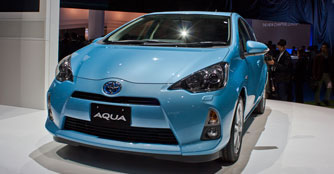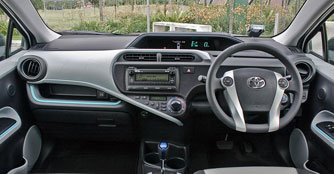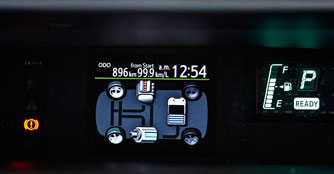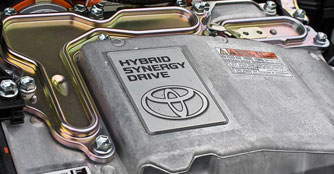Toyota Prius C Hybrid 1.5 (A) Review
03 Apr 2012|46,614 views
For a decade and a half, the Toyota Prius has been the leader of hybrid cars. And it wasn't until recently when Toyota decided to manufacture a smaller model of the Prius which would offer an even higher mileage compared to its predecessors.
Dubbed the Toyota Aqua in Japan, the production version of the hybrid was unveiled last year at the Tokyo Motor Show and it was only early this year at the North American International Auto Show in Detroit when the production Prius C concept was introduced.
Due to its compact size, this diminutive hatch of a hybrid has been created to excel in getting great mileage (as with the regular Toyota Prius) and manoeuvrability in tighter road conditions. But the 'C', as you would have considered, doesn't stand for 'compact'. Instead it stands for 'city'. As a result, the Prius C is most suited for around town and city driving, though there were no sign of problems getting the compact hybrid hatch up to speed on expressways around our sunny island.
Dubbed the Toyota Aqua in Japan, the production version of the hybrid was unveiled last year at the Tokyo Motor Show and it was only early this year at the North American International Auto Show in Detroit when the production Prius C concept was introduced.
Due to its compact size, this diminutive hatch of a hybrid has been created to excel in getting great mileage (as with the regular Toyota Prius) and manoeuvrability in tighter road conditions. But the 'C', as you would have considered, doesn't stand for 'compact'. Instead it stands for 'city'. As a result, the Prius C is most suited for around town and city driving, though there were no sign of problems getting the compact hybrid hatch up to speed on expressways around our sunny island.
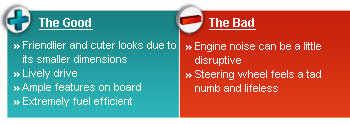 |
More importantly, the car continues to boast the sort of competent efficiency figures you would expect from a car that has the same hybrid powertrain as its bigger twin and that has always been the success for Toyota's celebrity hybrid. Perhaps the Japanese marque knew that a good way to ensure the longevity of a particular model was to continuously create more innovative iterations of an already successful model.
Exterior
Despite sharing a similar silhouette to the Yaris, the hybrid hatch is instantaneously recognisable as a Prius, thanks to the signature hybrid blue Toyota logo and 'hybrid' badging by either sides of the car. Its metal sheet remains to be inoffensive and is now a tad smaller. Unlike cars coming out from factories that have been marked as 'grown ups' and 'more aggressive', the Prius C is a newborn baby - friendlier, younger and cuter from all angles.
Up front, the car bears the same fascia as its bigger brethren with the sharp headlamps flanked by triangular foglight apertures while the rear end sports its very own chopped off design. Hence, tail lights are longer due to its high tail and appear to be more intact with the current modernised designs expected of cars.
 |
Interior
From any angle, it's hard to fault the car and the same goes for its interior, with its dual-toned dash, straightforward dials, leather upholstered benches and multi-functional steering wheel.
Toyota's mastery at packaging small cars allows tremendous benefits for occupants of the Prius C to enjoy. Despite the acres of plastic used, the cabin is a decent place to be in. Everything is solidly put together with absolutely no indication of insecurity. There are ample cubby holes too, providing front occupants with the convenience to place their barang-barang.
Space wise, the C is generous despite its undersized dimensions, with credits going to the battery pack located under the rear seats. This opens up additional room for passengers and boot space, while simultaneously improving the Prius C's handling. As a result head and legroom are ample all round for four passengers. We tried squeezing in the fifth, but the architecture of the centre console eats into the knee room of the middle passenger.
From any angle, it's hard to fault the car and the same goes for its interior, with its dual-toned dash, straightforward dials, leather upholstered benches and multi-functional steering wheel.
Toyota's mastery at packaging small cars allows tremendous benefits for occupants of the Prius C to enjoy. Despite the acres of plastic used, the cabin is a decent place to be in. Everything is solidly put together with absolutely no indication of insecurity. There are ample cubby holes too, providing front occupants with the convenience to place their barang-barang.
Space wise, the C is generous despite its undersized dimensions, with credits going to the battery pack located under the rear seats. This opens up additional room for passengers and boot space, while simultaneously improving the Prius C's handling. As a result head and legroom are ample all round for four passengers. We tried squeezing in the fifth, but the architecture of the centre console eats into the knee room of the middle passenger.
Just like its size, the cabin also features a small but intuitive 3.5 inch full colour Multi Information Display which also dominates the dash. It will show various images, such as the eco monitoring system, the eco score, fuel efficiency tracking and other trip computer and vehicle information - similar to what the Honda Civic Hybrid has but in a slightly more fun and witty design.
But what really took us by surprise is the list of standard features available in the hybrid. Able to put some bigger names to shame, the Toyota hybrid hatch includes Bluetooth, Aux-in/USB port and a myriad of safety features such as the Anti-lock Braking System (ABS), Electronic Brake-force Distribution (EBD), Brake Assist (BA), Traction Control (TRC), Hill Assist Control (HAC) and Vehicle Stability Control (VAC).
The test car you see here even came with a remote keyless entry, allowing us to lock and unlock the car without coming into contact with the key fob.
But what really took us by surprise is the list of standard features available in the hybrid. Able to put some bigger names to shame, the Toyota hybrid hatch includes Bluetooth, Aux-in/USB port and a myriad of safety features such as the Anti-lock Braking System (ABS), Electronic Brake-force Distribution (EBD), Brake Assist (BA), Traction Control (TRC), Hill Assist Control (HAC) and Vehicle Stability Control (VAC).
The test car you see here even came with a remote keyless entry, allowing us to lock and unlock the car without coming into contact with the key fob.
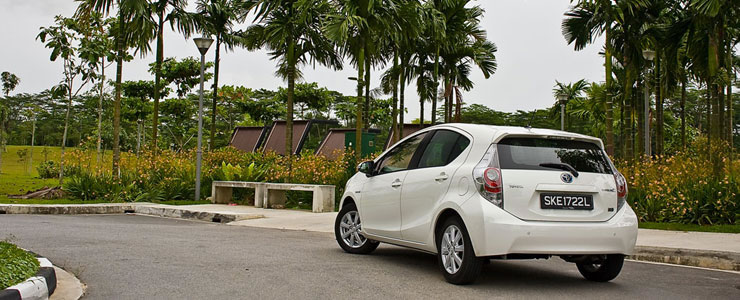 |
The Drive
By way of a push start button, the only sign that tells you that the car has fired up is the welcome note from the Multi Information Display. There isn't a single sound from the engine that gives itself away. Still, the car proves to be quite a lively little thing on the open road.
Despite its kerb weight of over 1.1 tonnes, the 1.5-litre hybrid powerplant will produce a maximum of 100 horses (74kW) and 111Nm of torque. It's no tarmac burning machine and it'll certainly not set your hair on fire from a traffic junction but considering that it's able to feel faster than the century sprint timing of 10.7 seconds, acceleration is more than adequate.
What's more important is the way it sips fuel while being driven hard. With figures such as 27km/L and 77g/km of CO2 emissions, the compact hybrid hatchback is one of the most fuel-efficient cars on sale in sunny Singapore. Although we weren't able meet the 27km/L mark, we managed to net 22km/L without even having the need to be light-footed.
By way of a push start button, the only sign that tells you that the car has fired up is the welcome note from the Multi Information Display. There isn't a single sound from the engine that gives itself away. Still, the car proves to be quite a lively little thing on the open road.
Despite its kerb weight of over 1.1 tonnes, the 1.5-litre hybrid powerplant will produce a maximum of 100 horses (74kW) and 111Nm of torque. It's no tarmac burning machine and it'll certainly not set your hair on fire from a traffic junction but considering that it's able to feel faster than the century sprint timing of 10.7 seconds, acceleration is more than adequate.
What's more important is the way it sips fuel while being driven hard. With figures such as 27km/L and 77g/km of CO2 emissions, the compact hybrid hatchback is one of the most fuel-efficient cars on sale in sunny Singapore. Although we weren't able meet the 27km/L mark, we managed to net 22km/L without even having the need to be light-footed.
Perhaps the only two complains about the car are the numb and lifeless steering wheel and the engine noise it produces, no thanks to the CVT transmission. But on the bright side, the car corners adequately, thanks to the weight distribution (battery pack is at the rear) and is able to do to so in a more refined and quieter manner than the recently launched Civic Hybrid.
Conclusion
Toyota makes no qualms about the minute size of its Prius C and further justifies it by noting that the C is targeted at the fun and younger audience. The fact that it's effortlessly efficient, and is in a perfectly practical package, is just icing on the cake. This compact hatch of a hybrid has such a lively attitude that it shows even when it's parked.
With a smaller footprint and price to match ($111,988 as of 8th March 2012), the Toyota Prius C should have no problems appealing to a whole new range of buyers.
Conclusion
Toyota makes no qualms about the minute size of its Prius C and further justifies it by noting that the C is targeted at the fun and younger audience. The fact that it's effortlessly efficient, and is in a perfectly practical package, is just icing on the cake. This compact hatch of a hybrid has such a lively attitude that it shows even when it's parked.
With a smaller footprint and price to match ($111,988 as of 8th March 2012), the Toyota Prius C should have no problems appealing to a whole new range of buyers.
For a decade and a half, the Toyota Prius has been the leader of hybrid cars. And it wasn't until recently when Toyota decided to manufacture a smaller model of the Prius which would offer an even higher mileage compared to its predecessors.
Dubbed the Toyota Aqua in Japan, the production version of the hybrid was unveiled last year at the Tokyo Motor Show and it was only early this year at the North American International Auto Show in Detroit when the production Prius C concept was introduced.
Due to its compact size, this diminutive hatch of a hybrid has been created to excel in getting great mileage (as with the regular Toyota Prius) and manoeuvrability in tighter road conditions. But the 'C', as you would have considered, doesn't stand for 'compact'. Instead it stands for 'city'. As a result, the Prius C is most suited for around town and city driving, though there were no sign of problems getting the compact hybrid hatch up to speed on expressways around our sunny island.
Dubbed the Toyota Aqua in Japan, the production version of the hybrid was unveiled last year at the Tokyo Motor Show and it was only early this year at the North American International Auto Show in Detroit when the production Prius C concept was introduced.
Due to its compact size, this diminutive hatch of a hybrid has been created to excel in getting great mileage (as with the regular Toyota Prius) and manoeuvrability in tighter road conditions. But the 'C', as you would have considered, doesn't stand for 'compact'. Instead it stands for 'city'. As a result, the Prius C is most suited for around town and city driving, though there were no sign of problems getting the compact hybrid hatch up to speed on expressways around our sunny island.
 |
More importantly, the car continues to boast the sort of competent efficiency figures you would expect from a car that has the same hybrid powertrain as its bigger twin and that has always been the success for Toyota's celebrity hybrid. Perhaps the Japanese marque knew that a good way to ensure the longevity of a particular model was to continuously create more innovative iterations of an already successful model.
Exterior
Despite sharing a similar silhouette to the Yaris, the hybrid hatch is instantaneously recognisable as a Prius, thanks to the signature hybrid blue Toyota logo and 'hybrid' badging by either sides of the car. Its metal sheet remains to be inoffensive and is now a tad smaller. Unlike cars coming out from factories that have been marked as 'grown ups' and 'more aggressive', the Prius C is a newborn baby - friendlier, younger and cuter from all angles.
Up front, the car bears the same fascia as its bigger brethren with the sharp headlamps flanked by triangular foglight apertures while the rear end sports its very own chopped off design. Hence, tail lights are longer due to its high tail and appear to be more intact with the current modernised designs expected of cars.
 |
Interior
From any angle, it's hard to fault the car and the same goes for its interior, with its dual-toned dash, straightforward dials, leather upholstered benches and multi-functional steering wheel.
Toyota's mastery at packaging small cars allows tremendous benefits for occupants of the Prius C to enjoy. Despite the acres of plastic used, the cabin is a decent place to be in. Everything is solidly put together with absolutely no indication of insecurity. There are ample cubby holes too, providing front occupants with the convenience to place their barang-barang.
Space wise, the C is generous despite its undersized dimensions, with credits going to the battery pack located under the rear seats. This opens up additional room for passengers and boot space, while simultaneously improving the Prius C's handling. As a result head and legroom are ample all round for four passengers. We tried squeezing in the fifth, but the architecture of the centre console eats into the knee room of the middle passenger.
From any angle, it's hard to fault the car and the same goes for its interior, with its dual-toned dash, straightforward dials, leather upholstered benches and multi-functional steering wheel.
Toyota's mastery at packaging small cars allows tremendous benefits for occupants of the Prius C to enjoy. Despite the acres of plastic used, the cabin is a decent place to be in. Everything is solidly put together with absolutely no indication of insecurity. There are ample cubby holes too, providing front occupants with the convenience to place their barang-barang.
Space wise, the C is generous despite its undersized dimensions, with credits going to the battery pack located under the rear seats. This opens up additional room for passengers and boot space, while simultaneously improving the Prius C's handling. As a result head and legroom are ample all round for four passengers. We tried squeezing in the fifth, but the architecture of the centre console eats into the knee room of the middle passenger.
Just like its size, the cabin also features a small but intuitive 3.5 inch full colour Multi Information Display which also dominates the dash. It will show various images, such as the eco monitoring system, the eco score, fuel efficiency tracking and other trip computer and vehicle information - similar to what the Honda Civic Hybrid has but in a slightly more fun and witty design.
But what really took us by surprise is the list of standard features available in the hybrid. Able to put some bigger names to shame, the Toyota hybrid hatch includes Bluetooth, Aux-in/USB port and a myriad of safety features such as the Anti-lock Braking System (ABS), Electronic Brake-force Distribution (EBD), Brake Assist (BA), Traction Control (TRC), Hill Assist Control (HAC) and Vehicle Stability Control (VAC).
The test car you see here even came with a remote keyless entry, allowing us to lock and unlock the car without coming into contact with the key fob.
But what really took us by surprise is the list of standard features available in the hybrid. Able to put some bigger names to shame, the Toyota hybrid hatch includes Bluetooth, Aux-in/USB port and a myriad of safety features such as the Anti-lock Braking System (ABS), Electronic Brake-force Distribution (EBD), Brake Assist (BA), Traction Control (TRC), Hill Assist Control (HAC) and Vehicle Stability Control (VAC).
The test car you see here even came with a remote keyless entry, allowing us to lock and unlock the car without coming into contact with the key fob.
 |
The Drive
By way of a push start button, the only sign that tells you that the car has fired up is the welcome note from the Multi Information Display. There isn't a single sound from the engine that gives itself away. Still, the car proves to be quite a lively little thing on the open road.
Despite its kerb weight of over 1.1 tonnes, the 1.5-litre hybrid powerplant will produce a maximum of 100 horses (74kW) and 111Nm of torque. It's no tarmac burning machine and it'll certainly not set your hair on fire from a traffic junction but considering that it's able to feel faster than the century sprint timing of 10.7 seconds, acceleration is more than adequate.
What's more important is the way it sips fuel while being driven hard. With figures such as 27km/L and 77g/km of CO2 emissions, the compact hybrid hatchback is one of the most fuel-efficient cars on sale in sunny Singapore. Although we weren't able meet the 27km/L mark, we managed to net 22km/L without even having the need to be light-footed.
By way of a push start button, the only sign that tells you that the car has fired up is the welcome note from the Multi Information Display. There isn't a single sound from the engine that gives itself away. Still, the car proves to be quite a lively little thing on the open road.
Despite its kerb weight of over 1.1 tonnes, the 1.5-litre hybrid powerplant will produce a maximum of 100 horses (74kW) and 111Nm of torque. It's no tarmac burning machine and it'll certainly not set your hair on fire from a traffic junction but considering that it's able to feel faster than the century sprint timing of 10.7 seconds, acceleration is more than adequate.
What's more important is the way it sips fuel while being driven hard. With figures such as 27km/L and 77g/km of CO2 emissions, the compact hybrid hatchback is one of the most fuel-efficient cars on sale in sunny Singapore. Although we weren't able meet the 27km/L mark, we managed to net 22km/L without even having the need to be light-footed.
Perhaps the only two complains about the car are the numb and lifeless steering wheel and the engine noise it produces, no thanks to the CVT transmission. But on the bright side, the car corners adequately, thanks to the weight distribution (battery pack is at the rear) and is able to do to so in a more refined and quieter manner than the recently launched Civic Hybrid.
Conclusion
Toyota makes no qualms about the minute size of its Prius C and further justifies it by noting that the C is targeted at the fun and younger audience. The fact that it's effortlessly efficient, and is in a perfectly practical package, is just icing on the cake. This compact hatch of a hybrid has such a lively attitude that it shows even when it's parked.
With a smaller footprint and price to match ($111,988 as of 8th March 2012), the Toyota Prius C should have no problems appealing to a whole new range of buyers.
Conclusion
Toyota makes no qualms about the minute size of its Prius C and further justifies it by noting that the C is targeted at the fun and younger audience. The fact that it's effortlessly efficient, and is in a perfectly practical package, is just icing on the cake. This compact hatch of a hybrid has such a lively attitude that it shows even when it's parked.
With a smaller footprint and price to match ($111,988 as of 8th March 2012), the Toyota Prius C should have no problems appealing to a whole new range of buyers.
Car Information
Toyota Prius C Hybrid 1.5 (A)
CAT A|Petrol-Electric|25.6km/L
Horsepower
74kW (99 bhp)
Torque
111 Nm
Acceleration
14.6sec (0-100km /hr)
This model is no longer being sold by local distributor
All Used Toyota Prius C HybridThank You For Your Subscription.





































